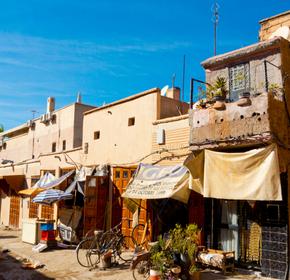
Fez travel guide
Fez Tourism | Fez Guide
You're Going to Love Fez
Fes was the medieval capital of Morocco and dates from 789 AD. It is home to the world's oldest university and is home to the best preserved old city in the Middle East and North Africa.

The old city, Fes el-Bali, is also the largest car-free urban center in the world, making Fes a great city to walk around.
Top 5 Reasons to Visit Fez
1. Walking in the Old City
The walled city center has three walking trails marked out to stop you getting lost. Green, orange, or blue trails will guide you through the palaces, ancient fortifications and gardens.
2. Seeing the Tanneries
At the heart of the medina, you will find the extraordinary and colorful sight of the ancient tanneries. A tour will cost just a few dirham.
3. Learn to Cook the Wonderful Food
Cooking classes in the medina include shopping for ingredients in the market. It's a great way to get closer to the city's culture.
4. Bou Inania Madrasa
Bou Inania Madrasa is a beautiful religious college, dating from the 14th century. It is the finest example of Islamic architecture in Fes that is open to non-Muslims.
5. The View from the Merenid Tombs
Climb to the Merenid Tombs and enjoy the finest views of the ancient city, as well as the fascinating site itself.
What to do in Fez
1. Medersa Bou Inania: Appreciate the Finest in Muslim Architecture
Morocco is known for its longtime attention to detail and beauty through ancient Muslim architecture. The most iconic madrasa exemplifying this unique style is the Medersa Bou Inania, located next to the Riad Palais Batha. The Islamic religious school was made in the 14th century and named after the sultan of Morocco Abu Inan Faris. Using a Marinid architectural style with an open inner courtyard and intricately tiled surface, the building has been carefully preserved and is now open to the public.
2. University of Al-Karaouine: Visit the Oldest University in the World
Despite the country's patriarchal ruling class, the University of Al-Karaouine was originally started as a Muslim school by a woman named Fatime al-Fihri in the 8th century. The building is structured like many other Moroccan madrasas, with delicate stone carvings, Emerald tiles, and luxurious handwoven carpets. The oldest of its kind still in operation, the University currently has just over 8,000 students studying subjects like math, physics, chemistry, and foreign languages. However the University still remains one of the most important religious schools in Islam.
3. Fes el Bali: Meander Through the Medieval Alleyways
As a tourist, there's nothing more annoying than having to stop in the middle of taking a picture to move for a car. Luckily for you, Fes el Bali is considered one of the largest car-free city centers in the world. However that bipedal freedom comes with a healthy dose of confusion, as street signs are often only in Arabic or are obscured altogether. Between the high walls, narrow alleys, and lack of signage, the magnitude of Fes el Bali is truly extraordinary. It is this sense of timelessness that prompted UNESCO to name Fes El Bali a World Heritage Site in 1981.
4. Mellah: Explore a Troubled History
Whether out of prejudice or protection, Jews living in Fez were quarantined within the ghetto of Mellah as early as the 15th century. The Jewish architecture is in stark contrast with the closed central-courtyard of traditional Moroccan homes, offering open balconies which looked out on the street below. At the peak of the Mellah's occupancy, there were a quarter of a million Jews living within these close quarters. Today, most of the original buildings have been abandoned with less than a hundred Jews remaining in the city of Fez due to political animosity.
5. Borj Nord: Enjoy the Cityscape Views
There is perhaps no way to get a better perspective on the city of Fez than a visit to Borj Nord. The two fortresses of Borj Nord in the North and its counterpart of Borj Sud in the South were commissioned by Sultan Ahmed al-Mansour in the 16th century to keep an eye on the rebellious city inhabitants. Borj Nord was built on the same level of the famous Merenid Tombs and offers some of its own artifacts and pictures from it's military history as the newly instated National Armory Museum.
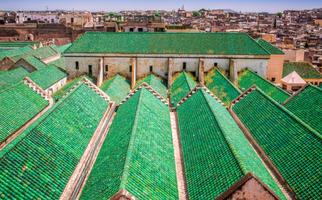
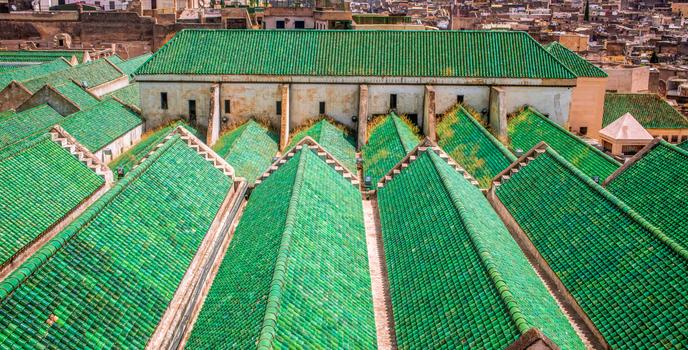
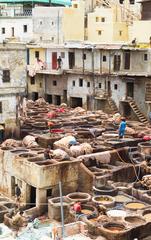
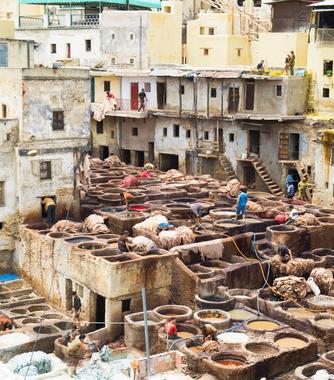
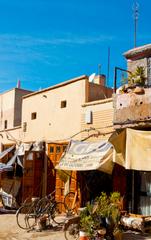

1. Medersa Bou Inania: Appreciate the Finest in Muslim Architecture
Morocco is known for its longtime attention to detail and beauty through ancient Muslim architecture. The most iconic madrasa exemplifying this unique style is the Medersa Bou Inania, located next to the Riad Palais Batha. The Islamic religious school was made in the 14th century and named after the sultan of Morocco Abu Inan Faris. Using a Marinid architectural style with an open inner courtyard and intricately tiled surface, the building has been carefully preserved and is now open to the public.
2. University of Al-Karaouine: Visit the Oldest University in the World
Despite the country's patriarchal ruling class, the University of Al-Karaouine was originally started as a Muslim school by a woman named Fatime al-Fihri in the 8th century. The building is structured like many other Moroccan madrasas, with delicate stone carvings, Emerald tiles, and luxurious handwoven carpets. The oldest of its kind still in operation, the University currently has just over 8,000 students studying subjects like math, physics, chemistry, and foreign languages. However the University still remains one of the most important religious schools in Islam.
3. Fes el Bali: Meander Through the Medieval Alleyways
As a tourist, there's nothing more annoying than having to stop in the middle of taking a picture to move for a car. Luckily for you, Fes el Bali is considered one of the largest car-free city centers in the world. However that bipedal freedom comes with a healthy dose of confusion, as street signs are often only in Arabic or are obscured altogether. Between the high walls, narrow alleys, and lack of signage, the magnitude of Fes el Bali is truly extraordinary. It is this sense of timelessness that prompted UNESCO to name Fes El Bali a World Heritage Site in 1981.
4. Mellah: Explore a Troubled History
Whether out of prejudice or protection, Jews living in Fez were quarantined within the ghetto of Mellah as early as the 15th century. The Jewish architecture is in stark contrast with the closed central-courtyard of traditional Moroccan homes, offering open balconies which looked out on the street below. At the peak of the Mellah's occupancy, there were a quarter of a million Jews living within these close quarters. Today, most of the original buildings have been abandoned with less than a hundred Jews remaining in the city of Fez due to political animosity.
5. Borj Nord: Enjoy the Cityscape Views
There is perhaps no way to get a better perspective on the city of Fez than a visit to Borj Nord. The two fortresses of Borj Nord in the North and its counterpart of Borj Sud in the South were commissioned by Sultan Ahmed al-Mansour in the 16th century to keep an eye on the rebellious city inhabitants. Borj Nord was built on the same level of the famous Merenid Tombs and offers some of its own artifacts and pictures from it's military history as the newly instated National Armory Museum.






Where to Eat in Fez
The area around the main gate into the Medina at Bab Bou Jeloud has some excellent street food stalls, with tasty snacks for just a few dirham. Le Palais de Fes is a rooftop restaurant offering great views and superb local dishes like pastilla, with dinner costing around DH350 per person.
When to visit Fez
With a hot Mediterranean climate, Fes endures scorching summers but is pleasantly warm from late fall to early spring.
How to Get to Fez
Plane
Fes' main airport is Fes-Saiss Airport (FEZ), around 10 miles from the city center. There are regular flights to major European cities. The number 16 bus will take you into town for DH4 or a taxi costs around DH150.
Train
The main railway station in Fes is Fès-Ville. It has regular connections to other Moroccan cities, such as Casablanca, Tangier, and Marrakech. The fare from Marrakech is DH295 for a first class ticket.
Car
The A2 road connects Fes with Casablanca, Rabat, and Oujda. Remember the large pedestrian center in the city itself.
Bus
The main bus terminal is at Gare Routière in the north of the old city and has extensive connections to other Moroccan cities.
Airlines serving Fez
Where to stay in Fez
Fes el-Bali (Medina) - this is Fes' ancient center. It has some good boutique hotels and is a thrilling place to stay.
Popular Neighborhoods in Fes
Fes el-Jdid - this district dates from the 13th century and is home to the Jewish Quarter and Royal Palace.
Ville Nouvelle - this is the newer, French Colonial part of the city, with comfortable squares and wide, tree-lined avenues.
Where to stay in popular areas of Fez
Most booked hotels in Fez
How to Get Around Fez
Public Transportation
The Fes bus network operating from Gare Routière serves the city and has fares from DH4.50
Taxi
Taxis are plentiful and cheap. Look out for the official red taxis, which have a starting fare of DH20 and then cost around DH4 per mile.
Car
The large pedestrianized center makes driving in the city inconvenient but driving in Ville Nouvelle is possible. Rental companies include Rami Rent Car Fes and Avis, and prices start at around DH130 per day.
The Cost of Living in Fez
Shopping Streets
The Ville Nouvelle area is best for fashion and has some designer stores. The medina is great for almost everything else and specializes in leather goods.
Groceries and Other
There are some French supermarkets, such as Carrefour, in the city. A quart of milk costs DH1.65 and a loaf of bread DH0.88.


